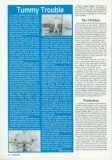“It’s like a Forties cartoon on amphetamines!” explains writer/animator Mark Kausler, when describing the crazy entertainment to be found in the new Roger Rabbit short Tummy Trouble, soon to be released with Disney’s Honey, I Shrunk the Kids. “It’s a lot faster and a lot more in your face than the real Forties cartoons were because they didn’t have the budgets or care expended on them.”
In fact, the classic Warner Brothers cartoons of the golden era of animation were the result of an uphill struggle with faceless, uncaring studio executives, who only employed animators because their work provided good programme fillers for theatres. The artists at the Disney Studio, however, had the full support of their boss, the late Walt Disney, and it’s a legacy which has been handed down to a new generation of young animators.
It was this same legacy which made Who Framed Roger Rabbit such a phenomenal success both artistically and financially, and changed Hollywood’s attitude towards the art of the animated film. It was inevitable, therefore, that its star, the crazy, likeable and madcap Roger would be considered for new cinematic adventures along with his voluptuous wife Jessica and co-star Baby Herman. While discussions continue over a feature-length sequel, the Disney Company are keeping the image of the hare-brained hero alive in a new series of animated shorts. The first of these draws its inspiration from Richard William’s prologue in Who Framed Roger Rabbit called Somethin's Cooking. Director Rob Minkoff knew that the care and attention lavished on the feature would somehow have to be transferred to each and every one of the new Roger shorts. “We are battling pressure” he told journalist Jim Fanning, “and my own experience, trying to match the quality of Somethin's Cooking... which was pretty outstanding.”
In Tummy Trouble, Baby Herman accidentally swallows his rattle. Panic stricken, Roger takes him to the local hospital where all manner of mayhem ensues. Roger is flattened, smashed to pieces and electrocuted. But like the great cartoon stars before him, Tom and Jerry, Wile E Coyote and Donald Duck, Roger bounces back for more. “We had several choices” remembers Kausler, “We had Roger in a restaurant (tentative title Hare in My Soup) and one in a circus, and then we wound up doing him in a hospital. That was the picture that finally got picked because Bob Zemeckis thought the setting of a hospital was funny and Steven Spielberg liked it too!”
Additional pressures for the filmmakers were that for the first time in the history of animation, the general public were able to watch them at work, following all stages of the four month production schedule. Tummy Trouble was the first film to be made at the Animation facility in the new Disney/MGM Studio Theme Park in Walt Disney World, Florida. Walkways allow visitors to watch the artists, technicians and camera operators at work. It’s just one way of making the public more appreciative of how much time and energy goes into the creation of an animated film. Certainly this work is impressive enough, but Tummy Trouble does lack the innovation of Somethin's Cooking. In Roger’s first screen adventure, the epitome of all those zany cartoons produced by Tex Avery and Bob Clampett, it was apparent that directors Williams and Zemeckis were trying to imitate the great animators’ style.
The character of Roger Rabbit has been called unsympathetic by some critics. But as Mark Kaulser explained to Jim Fanning, the challenge is trying to get the Disney side of him to work with the Tex Avery side. “He’s a combination of so many things. He has his cute aspects and he’s also wacky, so sometimes it’s hard to do both at the same time..."
Whatever the pitfalls, the box-office draw of Tummy Trouble and the enthusiasm generated by audiences for the soon to be released (in America) Rollercoaster Rabbit, will ensure a rosy future for one of Hollywood’s brightest new stars, the inimitable, the unique, Roger Rabbit.
